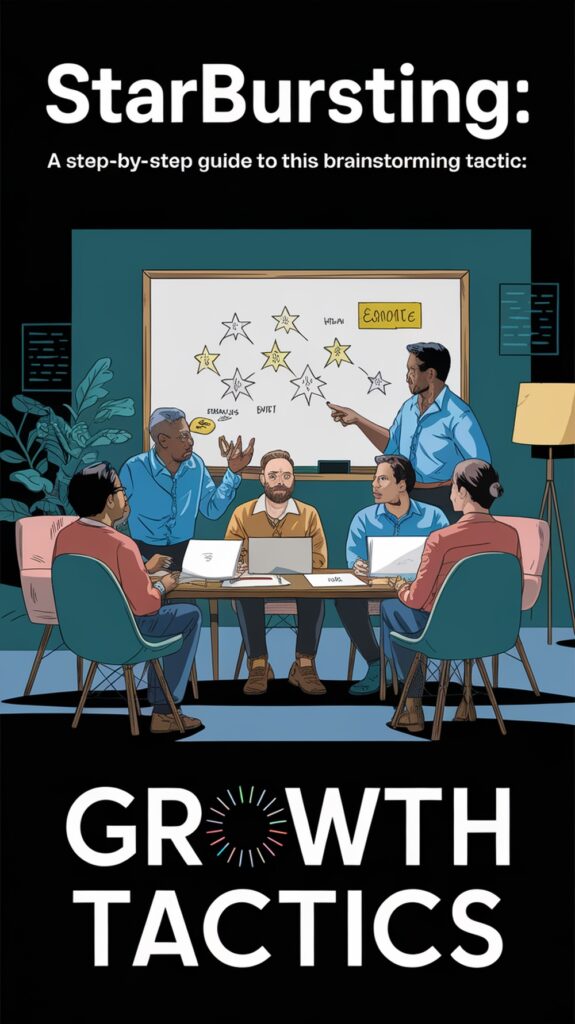Starbursting is a form of structured brainstorming focused on developing ideas and concepts by answering specific questions. It goes into the who, what, where, when, why, and how of a big idea or issue.
This approach promotes a culture of critical thinking. It helps cover every angle, making it particularly valuable in the earlier stages of project planning or innovation.
By focusing questions on a key concept, teams can quickly identify new opportunities and explore possible challenges from the outset.
Jump To Section
What is Starbursting?

Starbursting is a creative brainstorming technique specifically focused on creating deep, pointed questions instead of shallow answers. At its heart, it’s a tool for cultivating curiosity and systematic inquiry, guiding people or teams to a 360-degree exploration of an idea.
The method is visually represented as a six-point star, with each point corresponding to one of the fundamental question types: who, what, when, where, why, and how. This framework helps ensure that all aspects of an idea or issue are looked at thoroughly.
Definition and Core Concept
At its core, starbursting starts with a main concept or question. Shifting the focus away from solutions, participants ask questions that explore the concept’s numerous facets.
For instance, when planning for a new product launch, you may start by asking “Who is our target audience?” or “What needs is it addressing?” These questions are wonderful launching off points.
The six-point star framework serves as a structural compass, encouraging conveners and participants to come up with many questions in each category. This provides a solid base for further investigation, double-checking that no important nuance is missed.
This is different than traditional brainstorming, where you’re focusing on generating creative new ideas. It’s not about predicting the future, it’s about finding the gaps and setting a foundation for smarter decision-making.
How Starbursting Differs from Traditional Brainstorming
In traditional brainstorming, there is a pretty big push on letting the ideas flow and just going with it even if you go off-topic. Starbursting offers a clear methodology that ensures discussions remain on topic. By focusing on clear questions, it limits the guesswork and reveals gaps that need to be explored further.
This approach is great at surfacing missed considerations up front, which saves time and money down the road.
Why Starbursting is Essential for Problem-Solving
The real power of starbursting is its focus on fully unpacking the challenge at hand. By reframing issues with pointed questions, it promotes a complete picture of what’s most important. This method creates effective creative problem solving because it trains all participants to learn how to look at problems in different ways.
For instance, prompt questions like “What are possible hazards?” or “Where could chokepoints develop?” can uncover actionable, proactive details. Starbursting is best in collaborative environments!
It facilitates teamwork by getting everyone on the same page with a common structure for questioning. In the end, this approach makes sure that challenges are deeply understood before entering into solution-mode.
Benefits of Using Starbursting in Creative Processes

Starbursting fosters a structured approach to idea development. It brings to light overlooked opportunities or issues. This collaborative aspect of Starbursting encourages hands-on engagement, making sure that each individual on the team brings their distinct point of view to the table.
By ensuring broad inclusivity, this process often leads to a richer array of creative solutions, whether it’s a standout product feature or a more effective marketing strategy.
Steps for Effective Starbursting
Here are the key steps to take to conduct a successful Starbursting session.
1. Identify the Central Idea or Problem
Start by stating the issue or opportunity you want to research. Consider it a guiding star for the whole process, but the more specific you can get, the better.
For example, if your priority is getting a new product to market, say so up front. For instance, declare, “Creating a marketing strategy for Product X.” Make sure everyone is on the same page with this focus so you don’t end up going in different directions during your brainstorming.
2. Create a Six-Pointed Star Framework
Next, create a large six-point star on a whiteboard, large piece of paper, or digital tool. Label each point of the star with one of the six core categories: who, what, when, where, why, and how. Providing this visual framework allows you to both organize cross-cutting conversations and maintain a productive session structure.
3. Define Key Question Categories
For each category, customize questions based on the project’s needs. For instance, if analyzing a product launch, “Who is the target audience?” fits “Who,” while “What features should be prioritized?” aligns with “What.” Consider using a table or other chart to keep these categories organized and easy to understand.
4. Assign Roles and Facilitate Collaboration
Assign roles to keep the session focused. Designate a facilitator to guide the session and a note-taker to document questions. Appoint roles such as time keeper to keep the group on track. Support participation of all and utilize collaborative platforms for virtual groups.
5. Brainstorm Questions for Each Category
The goal is to come up with as many open-ended questions as possible. Go for volume, getting all thoughts on paper without self-censorship, like “Why would our customers choose this product instead of other options?”
6. Evaluate and Answer the Questions as a Team
Focus on the most pressing questions to develop concrete responses. Document your decisions and come back to unanswered questions in future sessions.
Scenarios for Using Starbursting

Versatility is what makes it so valuable across industries. Whether it’s business planning, marketing campaigns, product development, or team problem-solving this brainstorming technique is effective.
When to Use Starbursting in Business Planning
Starbursting is particularly effective during the early stages of business planning. Teams can use it to dive deep into market opportunities, evaluate risks, and formulate detailed strategies. For instance, when considering market expansion, a team might ask, “What regions offer the highest demand?” or “What barriers might we face?”
By generating and prioritizing such questions, businesses can identify gaps and refine their approach. This method supports hybrid teams, where participants brainstorm individually before collaborating in group sessions.
Applying Starbursting to Product Development
In product development, starbursting reveals important facets of design, focusing on how features address customer needs and highlighting possible obstacles. A team developing a new app might ask, “What problem does this solve for users?” or “What technical obstacles might arise during launch?”
This process not only clarifies product roadmaps but also assists with creating achievable timelines by tackling production difficulties from the start.
Using Starbursting for Marketing Campaigns
Marketing teams can find starbursting an invaluable practice to create creative new ideas for messaging and outreach, identify the best target audiences, and create measurable goals. For instance, a campaign team could ask, “What media will best engage our demographic?” or “What incentives will create the most engagement?”
These questions spark innovative outreach strategies and ground plans in research-based focus and purpose.
Adapting Starbursting for Team Problem-Solving
Collaboration Starbursting helps build trust and collaboration within a team by seeking and integrating diverse perspectives. Teams working on an internal workplace challenge could question, “What solutions benefit every stakeholder?” or “What resources will we need to implement this solution?”
Dividing sessions into time for generating questions and then focusing on solutions allows for discussion without letting loud voices take over.
Tips for Successful Implementation
In order to get the most out of starbursting, it’s important to be intentional and structured about the process. This approach works best when teams come ready, willing and able to engage in a meaningful collaborative discovery process.
Here are several important strategies to help you implement it successfully.
Set Clear Objectives and Time Limits
Start every session with a clear problem statement in the center of the Starbursting diagram. This serves as a north star for helping to create strong guiding questions. Couple this with specific, attainable goals to avoid drift.
Time constraints are just as important. Unlimited sessions tend to drag and lose energy. Consider using a timer or a structured agenda to help keep conversations focused and moving forward.
Break Sessions into Manageable Phases
Break sessions into manageable phases, i.e., from answering “who” and “what” questions to “how” and “why.” This phased approach not only prevents mental fatigue but also encourages thorough exploration. Develop a basic scoring rubric or flowchart to ensure the team is progressing methodically through each phase.
Encourage Individual Contributions Before Group Sharing
Individual ideation before group sessions encourages creative thinking and lessens the impact of groupthink. For example, encourage participants to submit questions anonymously through sticky notes or a group document. This approach allows for unique perspectives to be addressed while establishing an equitable starting point.
Use Digital Tools for Remote Collaboration
For these teams, tools like Miro provide asynchronous collaboration in addition to supporting real-time collaboration. Take advantage of these platforms to quickly visualize concepts and easily monitor progress. Digital shared spaces level the playing field so that participants in any location have their voices heard.
Continuously Refine Questions Over Time
As projects move along, return to questions and adjust them to incorporate updated information. Plan for regular evaluations to improve results and ensure the process evolves. Regular refinement keeps questions fresh and relevant, leading to actionable results.
Common Pitfalls in Facilitating Starbursting Sessions
A common pitfall is loss of focus, usually caused by unclear objectives or bad facilitation. Without a strong guiding question, these sessions can easily get bogged down and off track, costing valuable time. Teams can avoid this pitfall by articulating the goals of their discussion in advance and having a trained facilitator run the session to keep conversations focused.
The next pitfall is lack of balanced participation, where the loudest voices take over. This can suppress those who are less vocal and discourage a variety of ideas. To help manage balance, one solution is to ask participants to create questions on their own prior to sharing ideas with the larger group.
Finally, poor preparation like not giving appropriate context and tools can cause sessions to go off the rails. Proper facilitator training and provision of pre-session materials prevent this issue.
Overcoming Groupthink and Biases
Groupthink and other biases can prevent the inclusion of diverse perspectives. Supporting independent thought and ensuring that there is a safe, judgment-free space encourages vulnerability and openness.
Using structured questioning formats makes sure everyone’s voice is included. Anonymous voting or ranking can further neutralize dominant opinions, focusing attention on the most promising ideas to prioritize them objectively.
Ensuring Actionable Outcomes from Sessions
So Starbursting’s success lies in ensuring these sessions lead to actionable outcomes. Recording big picture questions, decisions, and who’s responsible for what turns the theoretical into the practical. Follow-up meetings keep everyone accountable and focused on making things happen and getting results.
Adapting Starbursting for Remote Teams
Virtual collaboration has its own set of challenges. Video conferencing and shared online platforms make participation easier, and intentional communication and scheduling around time zones help the whole group stay on the same page. Breaking sessions into short, focused segments keeps everyone engaged and stops the energy from lagging.
Conclusion
Starbursting is a fun, energizing, and highly structured method for idea generation. It achieves this through asking specific, probing questions that push teams and individuals to think beyond what’s at face value.
Its greatest worth is in sparking creativity and revealing possible pitfalls. It’s a powerful tool that fosters deep planning and exploration, whether you’re creating a new product, addressing a multifaceted challenge, or dreaming up creative solutions.
Ultimately, the success of Starbursting depends on fostering an open and collaborative environment where curiosity reigns. Use this technique to generate new ideas and create impact in your plans and policy decisions today!


